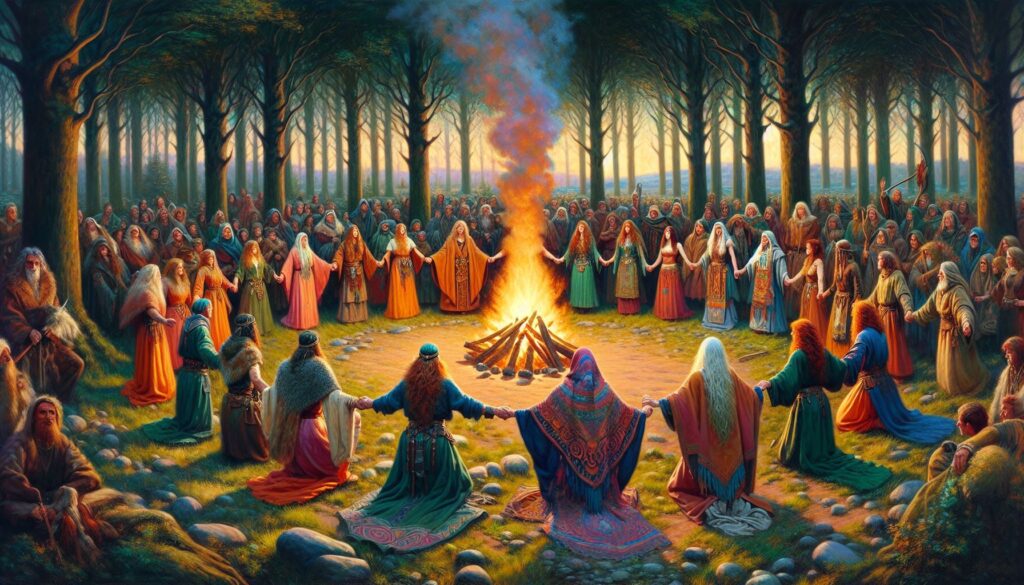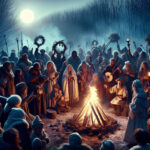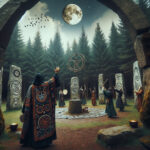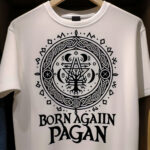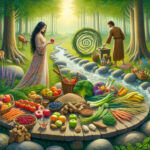Celtic Paganism, an ancient spiritual path rooted in the cultures and traditions of the Celtic peoples, has fascinated scholars and spiritual seekers alike for centuries. This comprehensive guide delves into the heart of Celtic paganism, exploring its rich mythology, revered deities, and the profound connection to nature that characterizes its practices. Through examining historical records, archaeological discoveries, and the revival of Celtic traditions in modern times, a multifaceted understanding of this ancient belief system emerges.
The essence of Celtic paganism lies in its deeply animistic worldview, seeing spirits and divine presence in all aspects of the natural world. The ancient Celts held trees, rivers, and animals in high regard, believing them to be imbued with sacred power. This reverence for nature is a thread that runs through much of Celtic religious practices, influencing everything from their ritual ceremonies to their art and storytelling.
Central to Celtic paganism is the pantheon of deities, each embodying different aspects of life and the natural world. These gods and goddesses were not distant figures but were intimately involved in the daily lives of the Celts, influencing their outcomes in war, agriculture, and community affairs. The role of the Druids, as priests and legal authorities, highlights the socio-religious system that integrated religious practices with the governance of Celtic society.
Despite the conversion to Christianity that swept through Celtic lands in the early medieval period, many aspects of Celtic paganism have endured. This resilience is a testament to the deep-rooted cultural identity and spiritual practices of the Celtic peoples. Today, the revival of Celtic paganism offers a window into the past, inviting modern practitioners to reconnect with the ancient traditions and wisdom of their ancestors.
Unveiling the Essence of Celtic Paganism
Celtic paganism, with its rich tapestry of myths, rituals, and deities, offers a glimpse into the spiritual life of the ancient Celts. This ancient belief system, deeply woven into the fabric of Celtic culture, emphasizes a profound connection with the natural world and the presence of the divine in everyday life. At its core, Celtic paganism is characterized by animistic beliefs, venerating the spirits residing in nature, from towering oaks to rushing rivers.
The practice of Celtic paganism was not monolithic but varied across different Celtic tribes and regions. Despite these variations, common elements such as the worship of a pantheon of gods and goddesses, the sacredness of natural sites, and the pivotal role of Druids as spiritual leaders, bind these practices together. Through rituals, seasonal festivals, and the oral tradition of storytelling, the ancient Celts celebrated their gods, honored their ancestors, and marked the cycles of the year, embedding their spiritual beliefs into the rhythm of daily life.
Defining Ancient Beliefs
The ancient Celtic religious system was a complex tapestry woven from threads of mythology, animism, and a powerful connection to the land. This spirituality was rooted in the belief of a world alive with spirits and deities, each playing a crucial role in the natural and human domains. The Celts perceived the presence of the divine in all aspects of life, making their religious practice deeply integrated with their everyday existence. From the veneration of the god of the dead to rituals involving ornaments with the dead, their practices reflected a nuanced understanding of life after death.
Notable historical figures such as Pliny the Elder provide insights into the druids, who were the intellectual and spiritual elite of Celtic society. These masters of traditional knowledge not only conducted religious festivals but also played a significant role in the socio-religious system from the 5th century onward. Despite the conversion to Christianity, which began in earnest in the 7th century, the church had succeeded in relegating druids to ignominious irrelevancy. However, the druids managed to retain a considerable part of their pre-Christian tradition, operating in easy harmony with their clerical counterparts during the Gallo-Roman period.
The Revival of Celtic Traditions in Modern Times
The resurgence of interest in the ancient Celtic religion and its practices in the 20th century has led to the emergence of Celtic Neopaganism. This revival seeks to reconstruct and reintegrate the old traditions within the modern spiritual landscape, drawing from historical texts, archaeological findings, and folklore to create a living, breathing faith for today. Countries such as the Czech Republic have seen a particular interest in these revived practices, reflecting a wider global trend towards exploring and embracing ancient belief systems.
Celtic religious practices, once at risk of being lost to history, are now experiencing a renaissance, allowing modern practitioners to explore and connect with their cultural heritage. This revival has not only led to the resurgence of traditional festivals and rituals but has also inspired a new appreciation for Celtic art, mythology, and philosophy. Through Celtic Neopaganism, individuals are finding ways to celebrate and integrate ancient Celtic spirituality into their lives, fostering a deeper connection to the natural world and the rich tapestry of Celtic cultural history.
The Pillars of Celtic Beliefs
The foundation of ancient Celtic religion and the broader spectrum of Celtic religions are built upon a profound reverence for the natural world, a rich pantheon of deities, and a deeply ingrained belief in the interconnectedness of all life. The revival of these ancient practices, particularly through Celtic Neopaganism in the 20th century, underscores the enduring appeal and relevance of Celtic spirituality. This resurgence, notably within regions like the Czech Republic, has rekindled interest in the ancient ways, melding historical traditions with contemporary spiritual exploration.
The Pantheon of Celtic Deities
At the heart of ancient Celtic religion was the worship of the Tuatha Dé Danann, a group of deities that embodied various aspects of the natural and cultural world. This pantheon includes figures of immense power and complexity, each contributing to the rich tapestry of Celtic myth and spirituality. The reverence for these gods and goddesses underscores the Celts’ deep connection to the elements, the land, and the cycles of life and death, weaving a spiritual narrative that is both vast and intimately personal.
The Dagda: Father Figure of the Celtic Gods
The Dagda, revered as a father figure among the Celtic gods, stands as a testament to the ancient Celts’ sophisticated spiritual hierarchy. Known for his immense strength, wisdom, and magical abilities, the Dagda governed aspects of life, protection, and abundance. His association with fertility, agriculture, and the seasons underscored the Celts’ deep connection to the land and its cycles. Julius Caesar’s accounts, alongside archaeological findings, suggest that burial practices among the Celts were influenced by beliefs in the afterlife, a realm the Dagda was closely associated with.
The Dagda’s role extended beyond the physical world, touching upon the spiritual and the mystical. His control over life and death, combined with his stewardship of the seasons, illustrates the Celts’ holistic view of existence, where the spiritual realm was in constant interaction with the earthly plane. The reverence for the Dagda and his depiction in Celtic art and mythology offer insights into the ancient Celts’ worldview, revealing a culture that valued harmony, balance, and respect for the forces of nature.
The Mórrigan: Goddess of Fate and Battle
The Mórrigan, a pivotal figure in the pantheon of gods and goddesses of the Celtic world, embodies the complex nature of Celtic spirituality. As the goddess of fate and battle, her presence was believed to influence the outcome of wars, weaving the threads of destiny with a keen understanding of the mortal and divine worlds. Her role as a protector and a challenger reflects the Celts’ nuanced perception of life, embracing its dualities and the inevitable cycle of life and death.
The Mórrigan’s significance extends beyond her martial aspects, touching upon themes of sovereignty, prophecy, and the protective forces of nature. Her representation in Celtic art and mythology captures the multifaceted nature of existence, portraying a deity who is both revered and feared. Through the stories and rituals dedicated to the Mórrigan, the ancient Celts expressed their deep respect for the forces that shape life, acknowledging the intricate dance between human endeavor and divine will.
Druids: The Esteemed Priests of Celtic Society
The druids, serving as the esteemed priests of Celtic society, held a position of significant authority and reverence. Their roles extended beyond the spiritual, encompassing legal, educational, and political duties. This multifaceted involvement allowed them to influence Celtic society profoundly, acting as mediators between the people and the divine. Their knowledge and wisdom, especially in matters of religious practice and lore, positioned them as key figures in sustaining the spiritual and social fabric of their communities. The druids’ relationship with their Roman counterparts highlights a complex interplay of cultural exchange and conflict, reflecting the broader dynamics of power and belief in ancient Europe.
Druids were not only spiritual leaders but also custodians of knowledge, responsible for the oral transmission of history, mythology, and law. Their deep connection to the natural world and its cycles was reflected in their rituals and teachings, which emphasized the sanctity of nature and the interconnectedness of all life. Through their guidance, the Celts navigated the challenges of their world, drawing upon the wisdom of the druids to maintain harmony within their communities and with the natural world around them.
Animistic Practices and the Sanctity of Nature
The animistic practices of the Celts underscored their profound reverence for the natural world. This worldview saw every tree, river, and stone as imbued with spirit, deserving of respect and honor. Such beliefs fostered a lifestyle that sought harmony with the environment, recognizing the interconnectedness of all living things. Celtic art, with its intricate patterns and motifs, reflects this deep connection to nature, often depicting animals, trees, and natural elements in stylized forms that convey a sense of the sacred.
This sanctity of nature was not merely aesthetic but deeply spiritual, influencing daily life, agricultural practices, and seasonal observances. The Celts’ recognition of the natural world as a living, breathing entity brought a sense of unity and purpose, guiding their interactions with the land and each other. Through their animistic practices, the ancient Celts cultivated a relationship with the environment that was reciprocal and respectful, embodying a worldview that remains profoundly relevant in today’s increasingly disconnected society.
Head Cult and Votive Offerings
The practice of head cults among the Celts underscores their belief in the head as the seat of the soul, embodying power and wisdom. This reverence is evident in their votive offerings, where heads of enemies, believed to capture the essence and power of the person, were prominently displayed or deposited in sacred sites. Renowned archaeologist Barry Cunliffe notes such practices were prevalent across Celtic territories, highlighting their significance in religious and social contexts.
By the 1st century AD, these practices had evolved, incorporating more symbolic representations in votive offerings. These offerings, ranging from intricately carved stone heads to wooden representations, were not solely focused on warfare trophies but also served as petitions or thanks to the deities. They were commonly placed in wells, rivers, or other bodies of water, which were considered portals to the otherworld, further emphasizing the Celts’ animistic view of their environment.
Celebrating the Celtic Calendar: Origins and Festivals
The Irish calendar, with its deep roots in Celtic tradition, structured time around the natural cycles of the earth, illustrating the Celts’ profound connection to nature. This calendar delineated the year into four main festivals—Imbolc, Beltane, Lughnasadh, and Samhain—each marking significant seasonal changes and agricultural cycles. By the 19th century, although the original practices had transformed, these festivals endured, symbolizing the enduring legacy of Celtic traditions through celebrations of harvest, fertility, and the honoring of ancestors.
These festivals, enriched by myths and linked to various deities, played a crucial role in the communal and spiritual life of the Celts. They not only marked time but also created opportunities for communities to come together, reaffirm social bonds, and engage in rituals that ensured the balance and continuity of life. Despite the passage of centuries and the influence of external cultures, the essence of these celebrations has been preserved, reflecting the resilience and adaptability of Celtic traditions.
The Importance of Sacred Spaces: From Natural Sanctuaries to Temples
In the 4th century BC, the Celts revered natural landscapes as embodiments of divine presence, with places like the Hill of Tara and Emain Macha (Navan Fort) holding profound spiritual significance. These sites, considered as portals to other realms, were often chosen for their unique features—rivers, mountains, or forests—that encapsulated the Celts’ animistic beliefs. The human heads, believed to house the soul, were frequently deposited in these sacred spaces, particularly in deep shafts in Southern Germany, as offerings to the gods, highlighting the Celts’ reverence for both the natural world and the afterlife.
With the expansion of the Roman Empire, these practices began to intermingle with Roman religious customs, leading to the construction of temples in sacred sites. However, the Celts maintained their spiritual connection to the natural world, integrating their animistic practices within these new structures. The blend of natural sanctuaries and temples illustrates the adaptive nature of Celtic spirituality, capable of evolving yet retaining its core reverence for nature and the divine.
Historical Insights and Archaeological Discoveries
Celtic art, with its intricate designs and motifs, provides a window into the spiritual and daily life of the Celts. These artifacts, dating back to the 4th century BC, often feature accompanying inscriptions that belong to the Roman period and reflect a considerable fusion of cultures. Despite the absence of a preserved literature on mythology, these pieces offer valuable insights into Celtic beliefs and practices. The art, derived from pre-Roman tradition, serves as a crucial tool for historians and archaeologists to interpret the past, bridging the gap left by the absence of written records.
The challenge of interpreting Celtic art and inscriptions in the absence of a preserved literature is significant, yet it opens avenues for understanding the nuanced beliefs and practices that characterized ancient Celtic societies. The motifs found in these artifacts, ranging from intricate knotwork to depictions of deities, not only illustrate the Celts’ artistic prowess but also their spiritual depth. Through careful analysis, scholars can piece together the fragments of Celtic life, offering glimpses into a world where art, religion, and society were deeply intertwined.
Tracing the Origins through Archaeological Sources
Archaeological discoveries have been instrumental in tracing the origins of Celtic culture, revealing a civilization rich in artistry and complex societal structures. Celtic art, characterized by its intricate designs and symbolic motifs, often accompanied by inscriptions, provides a tangible connection to the past. These artifacts, many of which belong to the Roman period, reflect a considerable cultural intermingling yet clearly derive from a strong pre-Roman tradition. This blend of influences offers insights into the adaptability and resilience of the Celts amidst changing political landscapes.
The absence of preserved literature on Celtic mythology and history has made archaeological sources invaluable for understanding this ancient culture. Through the study of artifacts, from ornate jewelry to ceremonial weapons, researchers can decipher aspects of Celtic life, religious practices, and societal organization. These findings, while challenging to interpret in the absence of written records, contribute significantly to our knowledge of the Celts, bridging the gap between historical conjecture and evidence-based understanding.
Insights from Irish, Welsh, Greek, and Roman Records
The religious practices of the Celts, particularly in Ireland and Wales, have been illuminated through the records left by Greek and Roman writers. These accounts, while often written from an outsider’s perspective, provide crucial insights into the traditional Celtic ways of worship, societal norms, and the pantheon of gods they revered. Despite the potential for bias in these records, they offer a glimpse into a world where nature, the divine, and the community were deeply interconnected, highlighting the Celts’ reverence for the natural world and their deities.
These records also shed light on the complexity of Celtic society and its religious practices, revealing a civilization that was both sophisticated and deeply spiritual. The integration of traditional Celtic beliefs with those of the Romans, particularly after the Roman conquest of Celtic lands, showcases a period of cultural exchange and adaptation. Through the lens of these historical records, the rich tapestry of Celtic spirituality and its influence on the broader European religious landscape is revealed, underscoring the enduring legacy of the Celts.
The Influence of Gallo-Roman Beliefs on Celtic Practices
The Gallo-Roman period marked a significant phase in the evolution of Celtic practices, as the ancient Indo-European traditions of the Celts began to intertwine with Roman religious customs. Pliny the Elder, among others, documented this cultural synthesis, noting the introduction of gods like the god of the dead, and practices such as placing ornaments with the dead to ensure a prosperous life after death. This period saw the Celts adapting their religious festivals and rituals to accommodate Roman influences, while still retaining a considerable part of their pre-Christian tradition.
By the 7th century, the church had succeeded in relegating druids to ignominious irrelevancy, yet the socio-religious system from the 5th century onward managed to retain key elements of Celtic belief. The Gallo-Roman period, therefore, represents a time of significant religious transformation, where the Celtic and Roman pantheons operated in easy harmony with their clerical counterparts. This coexistence allowed for the preservation of many Celtic practices, even as the conversion to Christianity began to take hold, showcasing the resilience of Celtic spirituality in the face of sweeping religious change.
The Collision with Christianity
The introduction of Christianity to Celtic lands marked the beginning of a profound transformation in Celtic religious practices and societal structures. This transition was not abrupt but occurred gradually, as Christian missionaries and monks began to integrate Christian beliefs with traditional Celtic spirituality. The process was characterized by both conflict and synthesis, with many Celtic practices being reinterpreted or absorbed into the Christian framework, leading to a unique blend of beliefs and rituals that reflected the merging of two distinct spiritual worlds.
Despite the efforts of the Christian church to supplant native Celtic practices, the spiritual landscape of Celtic regions retained elements of its pagan past. This enduring presence is evident in the survival of certain Celtic festivals, rebranded with Christian significance, and the persistence of myths and legends that continued to shape the cultural identity of these regions. The collision with Christianity, therefore, did not eradicate Celtic beliefs but rather transformed them, weaving them into the fabric of a newly emerging Christian tradition.
The Process of Christianisation
The Christianisation of Celtic lands unfolded through a series of strategic accommodations and adaptations of pre-existing Celtic rituals and festivals. Saints and Christian holy days were often aligned with traditional Celtic deities and celebrations, facilitating a smoother transition for the local populace. This process was not merely a matter of replacing one set of beliefs with another but involved the integration of Celtic spiritual heritage into the Christian narrative, preserving the essence of Celtic identity while introducing new religious concepts.
Monasteries became centers of learning and cultural preservation, playing a pivotal role in the Christianisation process. They served not only as religious institutions but also as repositories of both Christian and Celtic knowledge, including the recording of myths, legends, and history. Through such institutions, the continuity of Celtic cultural and spiritual traditions was ensured, even as the overarching religious landscape of the region underwent profound changes. The nuanced approach to Christianisation thus reflects a deep respect for and understanding of the complexity of Celtic spirituality.
Folkloristic Survivals into Modern Times
Despite the widespread Christianisation of Celtic societies, many aspects of Celtic paganism have survived into modern times, often interwoven with Christian practices. The reverence for Celtic gods, transformed into myths and legends, continued to play a role in the cultural consciousness of Celtic peoples. By the 19th century, a renewed interest in these ancient traditions sparked a revival of Celtic festivals and rituals, now celebrated with a blend of pagan and Christian elements, reflecting the enduring legacy of Celtic spirituality.
This resurgence of interest in Celtic paganism has led to the revival of ancient festivals, such as Samhain, which has evolved into the modern celebration of Halloween, and Beltane, which sees the lighting of fires to welcome the summer. These folkloristic survivals, while adapted to fit contemporary contexts, serve as a testament to the resilience of Celtic cultural and religious identities. They offer a bridge to the past, allowing modern practitioners to connect with the spiritual wisdom and practices of their ancestors, ensuring that the essence of Celtic paganism remains vibrant and accessible in the present day.
Preserving Celtic Paganism Today
In today’s rapidly changing world, the preservation of Celtic paganism reflects a deep-seated desire to connect with ancient roots and honor the earth. This preservation effort has taken various forms, from the revival of ancient rituals to the incorporation of Celtic symbols into everyday life. The essence of Celtic spirituality, with its emphasis on the natural world and the interconnectedness of all life, resonates with people seeking a more meaningful relationship with the environment and their heritage.
Technological advancements and social media have played a pivotal role in the resurgence of interest in Celtic paganism. Online forums, digital libraries, and social media platforms have become vital tools for sharing knowledge, organizing events, and fostering communities. This digital age has enabled the ancient Celtic religion to flourish once again, allowing individuals from all over the globe to explore and embrace these age-old traditions in contemporary settings.
Neo-Druidism and Celtic Reconstructionism
Neo-Druidism and Celtic Reconstructionism represent two significant movements within the modern revival of Celtic paganism. Neo-Druidism, focusing on the re-interpretation and revival of Druidic practices, emphasizes harmony with nature, creativity, and the spiritual growth of the individual. It draws inspiration from romanticized notions of ancient Druids as wise sages and guardians of mystical knowledge. Celtic Reconstructionism, on the other hand, strives for historical accuracy, delving into scholarly research to reconstruct the ancient Celtic religion as authentically as possible. This approach often involves studying insular Celtic languages and ancient texts to ensure fidelity to original beliefs and rituals.
Both movements share a common goal: the revival of the ancient Celtic religion in a manner that is respectful and true to its origins. While Neo-Druidism allows for more personal interpretation and spiritual exploration, Celtic Reconstructionism demands a rigorous adherence to historical practices. Together, they offer a spectrum of pathways for those looking to reconnect with Celtic paganism, catering to diverse preferences in spiritual expression and practice.
Celtic Neoshamanism and Wicca: New Paths of Old Traditions
Celtic Neoshamanism and Wicca represent modern spiritual paths that, while distinct, draw heavily from the wellspring of ancient Celtic beliefs. Celtic Neoshamanism focuses on the shamanic elements inherent in Celtic traditions, emphasizing journeying, spirit work, and the healing power of nature. It seeks to bridge the ancient and the modern by adapting shamanic practices within a Celtic framework. Wicca, although not exclusively Celtic, often incorporates elements of Celtic paganism, especially in its reverence for the gods and goddesses, seasonal festivals, and sacred rituals. This blend of old and new has attracted a diverse following, eager to explore spirituality through the lens of Celtic mysticism.
The appeal of these paths lies in their flexibility and the empowerment they offer practitioners to form personal connections with the divine. By drawing on the rich tapestry of Celtic mythology and cosmology, adherents find guidance, inspiration, and a sense of belonging to something greater than themselves. The gods and goddesses of the Celtic pantheon, with their vivid stories and complex characteristics, provide a profound source of wisdom and insight for those walking these spiritual paths.
The Role of Literature and Modern Media in Celtic Paganism’s Revival
Literature and modern media have been instrumental in sparking interest in Celtic paganism and influencing its contemporary revival. Fictional works, poetry, and scholarly books have woven the myths, legends, and spiritual practices of the Celts into narratives that captivate the imagination and inspire a deeper exploration of Celtic spirituality. Similarly, films, documentaries, and digital content have brought visual and auditory life to these ancient stories, making them accessible to a global audience.
This resurgence of interest has not only educated people about Celtic paganism but has also stimulated a desire to actively participate in its traditions. Through storytelling, both ancient and modern creators have played a crucial role in preserving the essence of Celtic beliefs, ensuring that they continue to enrich the spiritual lives of people today. The power of the word, both written and spoken, acts as a bridge between the past and the present, keeping the spirit of Celtic paganism alive in the hearts of many.
Delving Deeper into Celtic Paganism
For those drawn to the mysteries of Celtic paganism, a wealth of resources awaits to deepen their understanding and practice. From ancient texts to modern interpretations, the literature on Celtic spirituality offers a broad spectrum of perspectives on its rituals, deities, and philosophical underpinnings. Engaging with these materials not only enriches one’s spiritual journey but also fosters a greater appreciation for the cultural and historical context of the ancient Celtic religion.
Online platforms and local libraries have made it easier than ever to access both primary sources and contemporary works on Celtic paganism. Whether through academic books, practical guides, or digital articles, individuals can explore the complexities and nuances of this rich spiritual tradition. This journey of discovery not only strengthens personal beliefs but also connects seekers with a wider community of like-minded individuals, united by a shared reverence for the Celtic way.
Recommended Books and Resources
For those interested in delving deeper into Celtic paganism, several key books and resources stand out. Works like “The Druids” by Peter Berresford Ellis provide a comprehensive overview of the historical Druids, offering insights into their roles in Celtic society. “Celtic Myths and Legends” by Peter Berresford Ellis, again, serves as an engaging introduction to the captivating stories at the heart of Celtic spirituality. Additionally, “The Encyclopedia of Celtic Mythology and Folklore” by Patricia Monaghan is an invaluable resource for anyone looking to explore the breadth of Celtic mythological and folkloric traditions.
Online resources also play a vital role in the exploration of Celtic paganism. Websites like The Celtic Connection and Druidry.org offer extensive articles, guides, and forums for discussion, connecting individuals with a wealth of knowledge and a community of practitioners. These resources, among others, serve as gateways to a deeper understanding of the ancient Celtic religion, its practices, and its enduring legacy in the modern world.
Engaging with the Community: Festivals and Organizations
Engagement with the vibrant community of Celtic paganism enthusiasts can significantly enhance one’s spiritual journey. Festivals such as Beltane and Samhain offer opportunities to participate in ancient rituals, connect with nature, and celebrate the changing seasons in the company of others who share similar beliefs. These gatherings, often rich in music, dance, and storytelling, provide a living experience of Celtic spirituality, grounding participants in the traditions of their ancestors.
Beyond festivals, numerous organizations dedicated to the study and practice of Celtic paganism offer resources, workshops, and events to foster learning and community building. Groups like the Order of Bards, Ovates & Druids (OBOD) and The Celtic Reconstructionist Paganism Network play a crucial role in preserving and advancing the knowledge of Celtic spiritual practices. Through these festivals and organizations, individuals find not only a sense of belonging but also a platform to contribute to the ongoing revival of Celtic paganism.
Reflecting on Celtic Paganism’s Legacy and Future
The conquest of Gaul marked a pivotal moment in the history of ancient Celtic peoples, intertwining their fate with the expanding Roman Empire. This era, rich in cultural exchange, also signaled the beginning of a long period of decline for Celtic religious and cultural practices. Despite this, the legacy of Celtic deities, such as the god Cernunnos, known for his connection to nature and animals, and the goddess Epona, revered by horse lovers, continued to inspire. These mythological figures, alongside epic poems and stories preserved in Irish mythology, provide a window into the spiritual life of the ancient Irish and their profound connection to the natural world.
In the 21st century, there has been a resurgence of interest in these ancient traditions among contemporary pagans. This revival, often based on interpretations of historical and archaeological evidence, seeks to reconstruct the spiritual practices of the Celts, celebrating seasonal festivals and honoring the ancient pantheon. While some practices, like human sacrifices, remain firmly in the past, the emphasis on community, respect for nature, and the spiritual power of words and oaths—echoing how ancient Celtic warriors swore their oaths to their tribal gods—resonates with modern seekers.
The future of Celtic paganism looks promising, buoyed by a growing community of believers and the continued fascination with Celtic mythology and culture. As more people seek to connect with their ancestral roots or simply find meaning in the rich tapestry of Celtic spirituality, the traditions that once defined the lives of the ancient Celts are being reimagined for a new era. This blend of ancient wisdom and contemporary practice ensures that the legacy of Celtic paganism will continue to evolve, remaining relevant and vibrant in the modern world.

